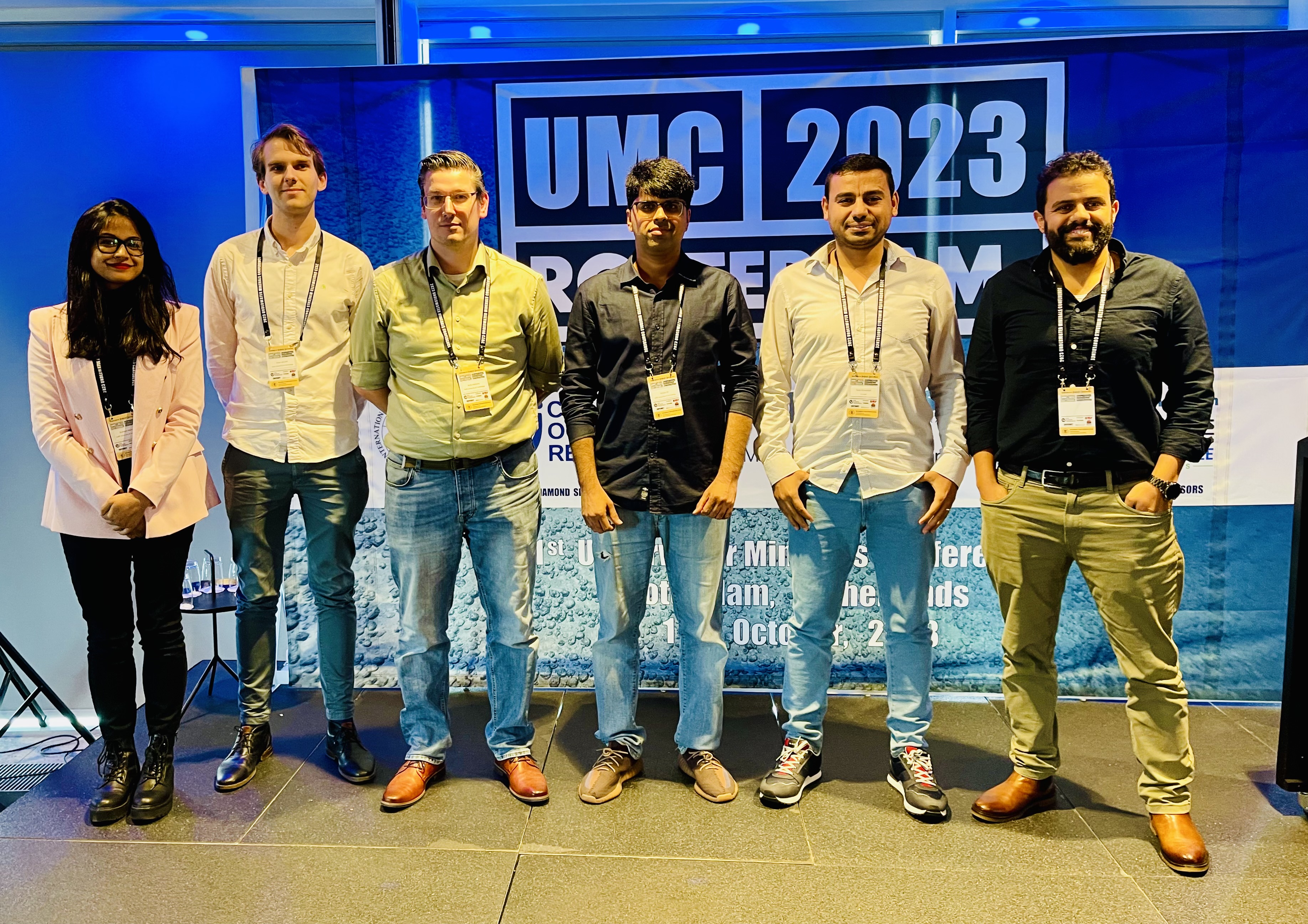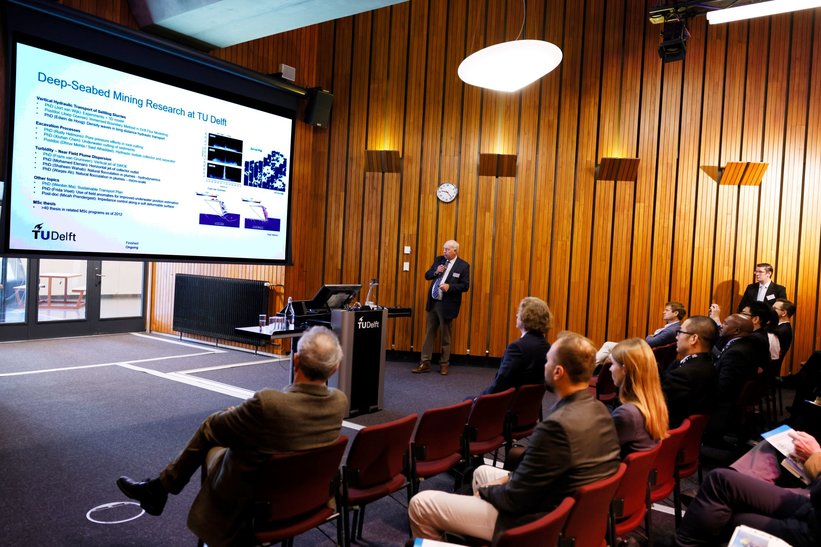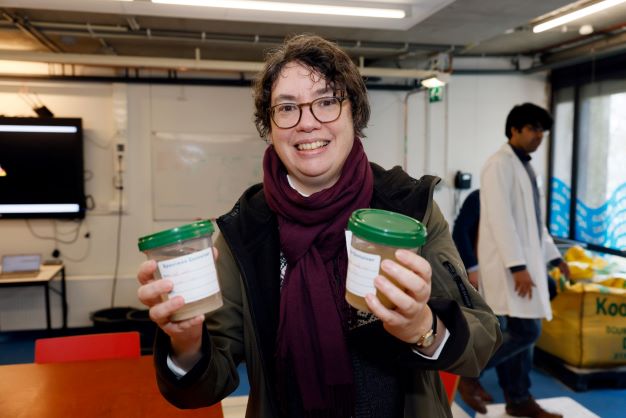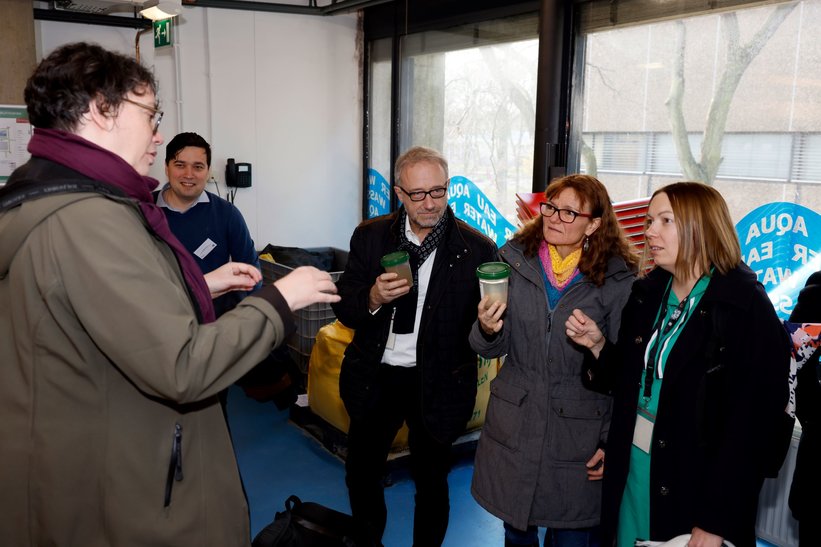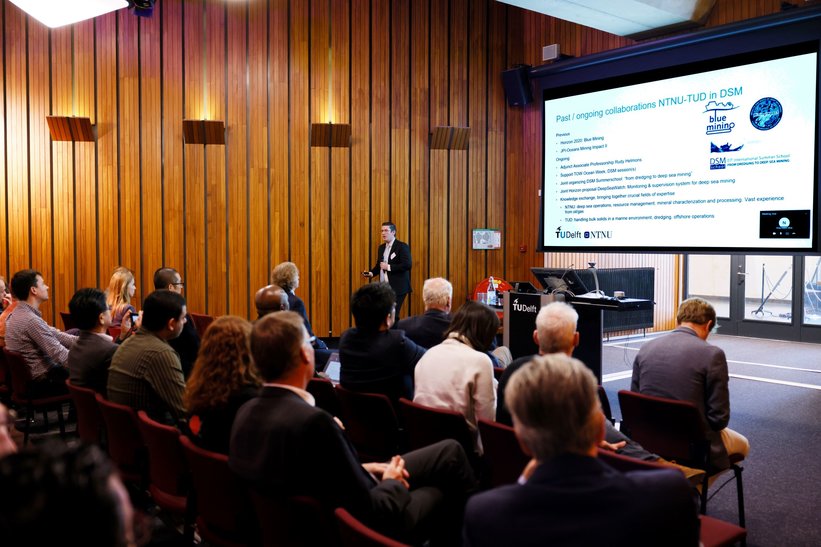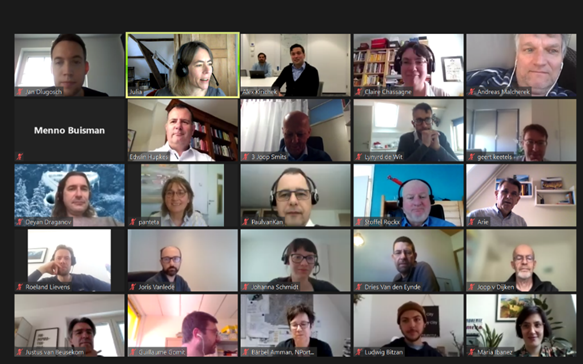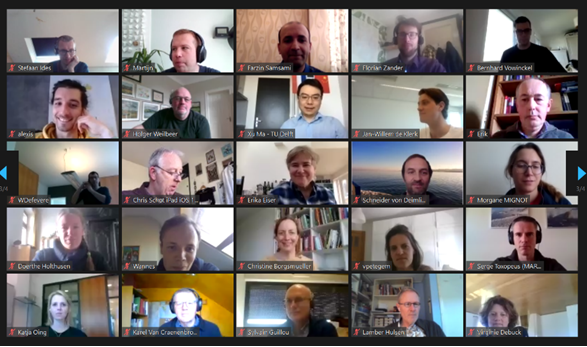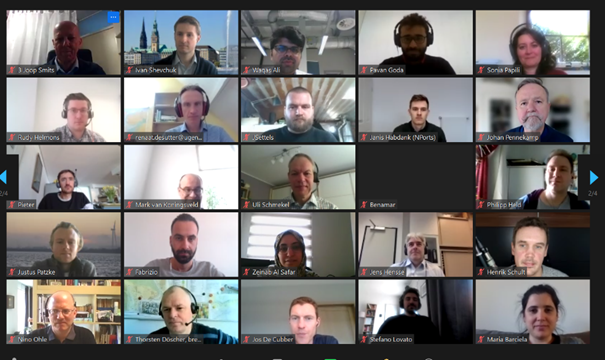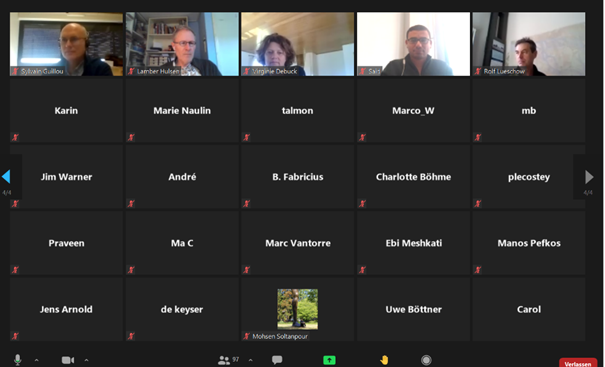Events
Upcoming Events/News items :
MUDNET presenting at CEDA Dredging Days 2024
Will be 27-29 May 2024. Presentations expected by Mark Winkelman, Shaheen Wahab and Waqas Ali.
Past Events/News items :
Hosting International Seabed Authority Annual Contractor meeting at TU Delft. Dec 6th 2022
First Mudnet conference 2021
On 29 and 30th of March, we held our first MUDNET conference. About 110 persons attended the conference and more than 30 posters were presented. The goal of the meeting was to stimulate the interaction between scientists of different fields and between scientists and Port Authorities. The main topic of the conference was of course! mud, but focussed specifically the first day on sediment management from a port perspective. The second day the floor was given to academic research presentations in the form of invited keynotes and posters presentations.
The following keynotes were given on 29th of March:
Port of Rotterdam
PRISMA: program innovation sediment management
Edwin Hupkes, Joop Smits, Menno Buisman
Port of Hamburg
The Nautical Depth project in the Port of Hamburg
Nino Ohle
Port of Emden
Maintenance Dredging in Emden Harbour
Port of Emden pilot in INTERREG NON-STOP: intelligent sediment & water management
Bärbel Amman, Janis Habdank
Port of Antwerp
Challenges related to mud
Stefaan Ides, Wim Defevere
A general plenary discussion closed the exchanges, which was led by Stoffel Rockx from RIVM.
On the second day (30th of March), the presentations were categorized in different topics, as follows
RHEOMUD + FLOCMUD
keynote speaker: Philippe Coussot, Laboratoire Navier, Université Gustave Eiffel, Champs sur Marne
Yield stress and liquefaction of muds
Muds are generally suspensions in water of colloidal particles which can form a network of (colloidal) interactions at the origin of a yield stress. Depending on the characteristics of these interactions the rheological behavior of the material may range from simple viscoplastic (steric interactions, e.g. kaolin pastes) to strongly thixotropic yield stress fluids (flocculation, e.g. bentonite suspensions) which restructure at rest but somewhat liquefy beyond the yield stress, so that the apparent behavior during flow is that of a yield stress fluid with a lower yield stress than at rest. Even more surprising behavior can be obtained in some cases, for examples a wax suspension in oil or a phosphate mud with a flocculant are brittle yield stress fluids which, when yielding, become a simple Newtonian liquid with a low apparent viscosity.
The following related posters were presented:
RHEOMUD
Rheology of mud from the Port of Hamburg
A. Shakeel, A. Kirichek, C. Chassagne
Rheological behaviour of marine sediments for assessing nautical depth
A. Benamar, A. Pantet, M-T Ammami
Rheological measurements to improve the understanding of suspended sediment dynamics in the Ems estuary
C. Borgsmüller
A rheological model for mud which avioids the use of a yield stress
J. Schmidt, A. Malcherek
Rheology of cohesive suspensions: a preliminary approach towards the sediment transport
A. Bougouin, A. Jarno, A. Benamar, F. Marin, A. Pantet
FLOCMUD
Potential of bio flocculant for flocculating deep sea mining plumes
W. Ali, A. Kirichek, C. Chassagne
Quantifying Flocculation ettling Dynamics of Natural Fine-Grained Suspended Sediments : “Floccin’Across the USA!”
A. Manning
Dynamics of cohesive sediments
C. Chassagne, Z. Safar, A. Manning
Iron rich micelles at the continental shelf after iron ore tailing input
C. Grilo
Swelling clays detection in mud sediments
F. Deon, F. Zander, C. Chassagne, J. Gebert
Examining the erosional and depositional behaviour of cohesive sediments: Flocculation in an estuary
J. Rounce, A. Manning
BIOMUD
Keynote speaker: Justus van Beusekom, Helmholtz-Zentrum Geesthacht
Long-term SPM dynamics in the Elbe Estuary and adjacent coastal zone: interactions with phytoplankton underestimated?
The Elbe Estuary is experiencing manifold human induced changes including increased eutrophication, dredging activities superimposed on climate change. Based on long-term data we will show that SPM-dynamics in the Hamburg Harbour region changed over time from background riverine levels of about 20 mg/l to up to 5-fold higher present levels observed during low freshwater discharge. These changes were paralleled by dredging activities. The source of SPM in the harbour region changed toward a dominance of marine SPM. Interactions of eutrophication-induced massive riverine phytoplankton blooms and marine SPM lead to the deposition and degradation of organic-rich material in the harbour region, now being a hotspot of among others coupled nitrification - denitrification, O2 consumption and N2O release. Given the importance of marine SPM in the Elbe estuary and its deposition in the Hamburg Harbour area, we will discuss the interactions between eutrophication and SPM dynamics in the coastal North Sea.
The following related posters were presented:
Organic matter in river sediments
F. Zander, J. Gebert
Using Oligochaete worms for dewatering of soft fine grained sediment: an overview of progress
M. de Lucas, A. Kirichek, M. Kox, F. van Rees, R. de Sutter
SONIMUD
Keynote speaker: Johannes M Singer, Fugro NV, Chief Scientist, Fugro Nootdorp Research Center
Mapping Harbor Basins
A fundamental question for this meeting is: “Where is what, and how can we map it quickly and efficiently?”
I would like to provide in this keynote talk an overview on techniques used for mapping Harbor basins, the seafloor and the different layers where water gradually changes to solid, and the boundaries of the harbor basin including key walls. I will attempt an overview of techniques already applied in the industry (including but not restricted to Fugro), examples and case studies from literature, as well as an outlook how more recent techniques could contribute to this. These recent techniques focus on ideas and experiments, both in TU Delft and Fugro, on using seismic techniques to map the interface layers between water, mud and solid seafloor. Tools of choice include passive and active seismic investigating interface and surface waves with a high content of shear waves probing specifically the geotechnically relevant soil and mud parameters.
The following related posters were presented:
Investigation of Fluid Mud using seismic measurements
X. Ma, A. Kirichek, D. Draganov
NAUTIMUD
Keynote speakers: Mark Vantorre & Guillaume Delefortrie, Ghent University
Manoeuvring behaviour of vessels in muddy waters
The manoeuvring behaviour of vessels is highly affected by their small under keel clearance in access channels and harbours. If sedimentation and the formation of mud layers occur in these areas the manoeuvring behaviour becomes even more challenged, especially because the exact location of the bottom is not unequivocally determined. In such areas the nautical bottom definition, as stated by PIANC, should be applied. Over the past decades research at Flanders Hydraulics Research and Ghent University has been focussing on both the determination of the physical characteristics of the mud and the manoeuvring behaviour in such areas. The keynote will give an overview of this research.
The following related posters were presented:
A turbulence model for Herschel-Bulkley flows
S. Lovato, G.H. Keetels, J.W. Settels, S.L. Toxopeus
Simulation of a steady turning circle manoeuvre in contact with fluid mud
I. Shevchuk, M. Abdel-Maksoud
Experimental and numerical study of a cylinder passing through fluidized natural mud
M. S. Sotelo, D. Boucetta, B. Brouwers, G. Delefortrie
4DMUD
Keynote speaker: Andreas Wurpts, NLWKN Norden
Fluid Mud Modelling in the Ems Estuary
Lower Ems is a hyper-turbid estuary with severe ecological problems like anoxic conditions during the low discharge summer season. In order to prepare and optimize remediation options, NLWKN Coastal Research Station has developed a coupled hydro-morphodynamical numerical model, which is capable of seamless transition between turbulent free flow and non-Newtonian fluid mud flow. The presentation covers the model description, its application to the Ems estuary, and some validation against measured data.
Keynote speakers: Andreas Malcherek, Universität der Bundeswehr, München
On the simulation of muddy waters
A conceptual approach will be presented which is able to simulate the movement of muddy waters over the full range of clear, turbulent waters to suspensions to fluid mud as well as consolidating beds. It will be shown that this approach implemented in a 1DV model is capable to reproduce the complex tidal cycle of settling, stratification and resuspension measured in the Ems estuary.
The following related posters were presented:
Far-field dispersion of dredged material in the Port of Rotterdam area
T. van Kessel, K. Cronin, D. van Keulen
Detailed near field modelling of mud dredge plumes
L. de Wit
Modelling of deep sea mining generated plumes
M. Elerian, R. Helmons, C. van Rhee
Grain-resolved simulations of cohesive sediment dynamics
B. Vowinckel, K. Zhao, T. Hsu, B. Bai, E.Meiburg
Protocol to prepare the FHR’s consolidation set-up in the context of navigability through mud
M. Ibanez, D. Meire
Towards a generalized circular use of salty dredged sediments
M. Barciela-Rial, B. Felix, C. Vaz-Perez, W. van der Star, F. Haarman, E. Besseling, L. Sittoni
Beneficial use of dredged marine mud – from fresh mud to dike: implementation, monitoring and modeling
E. Meshkati, T. van Kessel, D. van Keulen, A. Talmon, G. Dupuits, P. Vardon, M. van den Heuvel, N. Nijborg, L. Sittoni, W. van der Star
At the end of the day, a plenary discussion about future research in connection with ports’ need was initiated by the MUDNET team with all attendees.

